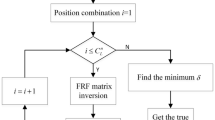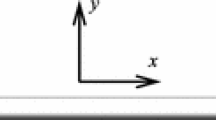Abstract
A new preconditioned modified conjugate gradient algorithm based on improved gradient operator and preconditioned technology is proposed for moving force identification of bridge structure in this paper. First, the moving load identification problem is converted into the problem of solving large-scale linear equations by the time-domain deconvolution technology and modal superposition method. Then the large-scale linear equations problem is transformed into easily solved equivalent problem by preprocessing. Subsequently, it is transformed into an unconstrained linear optimization problem by constructing the corresponding objective function. Finally, the problem is solved by the proposed conjugate gradient method. The innovation of the proposed method lies in two aspects. First, the proposed conjugate gradient method is proved by mathematical theory. Second, before constructing the objective function, the preconditioned technique is utilized to simplify the original problem. A series of numerical simulations are carried out to verify the stability and effectiveness of the proposed approach under 21 kinds of noise levels and 6 different sensor configurations, and its performances are compared with several conjugate gradient methods. The results show that the proposed method can reduce the iteration number, and also ensure the load identification accuracy, which indicates that the proposed method can improve the speed of identification and effectively reduce the cost. Meanwhile, the identification situation of different load components is studied by the frequency spectrum analysis method. It is found that the proposed method is a stable and a reliable identification method for static and low-frequency components, which provides a new idea for dynamic weighing of low-frequency loads on bridges.










Similar content being viewed by others
References
Law SS, Chan THT, Zeng QH (1997) Moving force identification: a time domain method. J Sound Vib 201(1):1–22
Huang LX, Deng ZC, Hou XH (2008) Precision analysis for dynamic moving load identification of bridge structure based on precise integration method. J Hebei Univ Sci Technol 29(2):124–127 ((In Chinese))
Hou XH, Deng ZC, Huang LX (2008) An improved symplectic precise integration method for moving load identification of bridge structure. J Dyn Control 6(01):66–71 (in Chinese)
Liu J, Meng XH, Jiang C, Han X, Zhang DQ (2016) Time-domain Galerkin method for dynamic load identification. Int J Numer Methods Eng 105:620–640
Uhl T (2007) The inverse identification problem and its technical application. Arch Appl Mech 77(5):325–337
Qiao GD, Rahmatalla S (2021) Moving load identification on Euler–Bernoulli beams with viscoelastic boundary conditions by Tikhonov regularization. Inverse Probl Sci Eng 29(8):1070–1107
Wang NJ, Ren CP, Liu CS (2018) A novel fractional Tikhonov regularization coupled with an improved super-memory gradient method and application to dynamic force identification problems. Math Probl Eng 1:1–16
Liu CS, Ren CP (2019) Identification method of cutting coal and rock load based on improved fractional Tikhonov regularization. J China Coal Soc 44(01):332–339 (in Chinese)
Chen Z, Chan THT (2017) A truncated generalized singular value decomposition algorithm for moving force identification with ill-posed problems. J Sound Vib 401:297–310
Chen Z, Qin LF, Zhao SB, Chan THT, Nguyen A (2019) Toward efficacy of piecewise polynomial truncated singular value decomposition algorithm in moving force identification. Adv Struct Eng 22(12):2687–2698
Chen Z, Chan THT, Nguyen A, Yu L (2019) Identification of vehicle axle loads from bridge responses using preconditioned least square QR-factorization algorithm. Mech Syst Signal Process 128:479–496
Chen Z, Qin LF, Chan THT, Yu L (2021) A novel preconditioned range restricted GMRES algorithm for moving force identification and its experimental validation. Mech Syst Signal Process 155:107635
Pan CD, Huang ZJ, You JD, Li YS, Yang LH (2021) Moving force identification based on sparse regularization combined with moving average constraint. J Sound Vib 515:116496
Qiao BJ, Zhang XW, Wang CX, Zhang H, Chen XF (2016) Sparse regularization for force identification using dictionaries. J Sound Vib 368:71–86
He ZC, Zhang ZM, Li E (2019) Multi-source random excitation identification for stochastic structures based on matrix perturbation and modified regularization method. Mech Syst Signal Process 119:266–292
Feng W, Li QF, Lu QH (2020) Force localization and reconstruction based on a novel sparse Kalman filter. Mech Syst Signal Process 144:106890
Wang LG, Zhang Q, Sun YL, Qing XR (2020) Moving load identification for STS cranes based on hybrid weighted regularization method. J Phys Conf Ser 1549(04):042109
Qiao BJ, Zhang XW, Luo XJ, Chen XF (2015) A force identification method using cubic B-spline scaling functions. J Sound Vib 337:28–44
Qiao BJ, Chen XF, Luo XJ, Xue XF (2015) A novel method for force identification based on the discrete cosine transform. J Vib Acoust 137(5):051012
Qiao BJ, Luo XJ, Chen XF, Xue XF, Liu RN (2015) The application of cubic B-spline collocation method in impact force identification. Mech Syst Signal Process 64:413–427
Liu J, Sun XS, Han X, Jiang C, Yu DJ (2015) Dynamic load identification for stochastic structures based on Gegenbauer polynomial approximation and regularization method. Mech Syst Signal Process 56–57:35–54
Liu J, Cao L, Jiang C, Ni B, Zhang D (2020) Parallelotope-formed evidence theory model for quantifying uncertainties with correlation. Appl Math Model 77:32–48
Yuan XR, Bu JQ, Man HG, Gao YL (2000) Function approaching method in moving load identification. J Vib Shock 19(01):58–70 (in Chinese)
Jiang ZG, Sun YR (2006) Application of cubic spline function to moving load identification on a bridge. J Vib Shock 25(06):124–126 (in Chinese)
Chen Z, Chan THT, Nguyen A (2018) Moving force identification based on modified preconditioned conjugate gradient method. J Sound Vib 423:100–117
Chisari C, Bedon C, Amadio C (2015) Dynamic and static identification of base-isolated bridges using genetic algorithms. Eng Struct 102:80–92
Pan CD, Yu L (2014) Moving force identification based on firefly algorithm. Adv Mat Res 919–921:329–333
Zhou P, Xin JH, Ding JC (2021) Least squares support vector machine method for load identification of nonlinear systems. J Noise Vib Control 41(05):9–37 (in Chinese)
Zhou JM, Dong LL, Guan W, Yan J (2019) Impact load identification of nonlinear structures using deep recurrent neural network. Mech Syst Signal Process 133:106292
Li HQ, Jiang JH, Mohamed MS (2021) Online dynamic load identification based on extended Kalman filter for structures with varying parameters. Symmetry 13(8):1372
Pinkaew T (2006) Identification of vehicle axle loads from bridge responses using updated static component technique. Eng Struct 28(11):1599–1608
Yang J, Hou P, Yang CQ, Zhang Y (2021) Study on the method of moving load identification based on strain influence line. Appl Sci 11(02):853
Qian CZ, Chen CP, Xiao YG (2014) Identification method for moving loads over continuous beam based on bending moment influence lines. Appl Mech Mater 638–640:1079–1084
Liu J, Li K (2021) Sparse identification of time-space coupled distributed dynamic load. Mech Syst Signal Process 148:107177
Jiang JH, Ding M, Li J (2021) A novel time-domain dynamic load identification numerical algorithm for continuous systems. Mech Syst Signal Process 160:107881
Zhu ZB, Zhang DD, Wang S (2020) Two modified DY conjugate gradient methods for unconstrained optimization problems. Appl Math Comput 373:125004
Hestenes M, Stifel E (1952) Methods of conjugate gradients for solving linear systems. J Res Nat Bur Stand 49:409–435
Polyak BT (1969) The conjugate gradient method in extremal problems. USSR Comput Math Math Phys 9(04):94–112
Dai YH, Yuan YX (1999) A nonlinear conjugate gradient method with a strong global convergence property. SIAM J Optim 10(01):177–182
Yao SW, Wei ZX, Huang H (2007) A note about WYL’s conjugate gradient method and its applications. Appl Math Comput 191(02):381–388
Wei ZX, Yao SW, Liu LY (2006) The convergence properties of some new conjugate gradient methods. Appl Math Comput 183(2):1341–1350
Huang H (2014) A new conjugate gradient method for nonlinear unconstrained optimization problems. J Henan Univ (Nat Sci) 44(02):141–145 (in Chinese)
Fan XT, Ji GM (2003) Preconditioned matrix and its structure technique. J Chengdu Univ Technol (Sci Technol Ed) 30(04):432–435 (in Chinese)
Acknowledgements
Funding was provided by National Natural Science Foundation of China (Grant No. 51975324) and Open Fund of Hubei key Laboratory of Hydroelectric Machinery Design and Maintenance (Grant No. 2019KJX12).
Author information
Authors and Affiliations
Corresponding author
Additional information
Publisher's Note
Springer Nature remains neutral with regard to jurisdictional claims in published maps and institutional affiliations.
Rights and permissions
Springer Nature or its licensor (e.g. a society or other partner) holds exclusive rights to this article under a publishing agreement with the author(s) or other rightsholder(s); author self-archiving of the accepted manuscript version of this article is solely governed by the terms of such publishing agreement and applicable law.
About this article
Cite this article
Luo, C., Wang, L., Xie, Y. et al. A New Conjugate Gradient Method for Moving Force Identification of Vehicle–Bridge System. J. Vib. Eng. Technol. 12, 19–36 (2024). https://doi.org/10.1007/s42417-022-00824-1
Received:
Revised:
Accepted:
Published:
Issue Date:
DOI: https://doi.org/10.1007/s42417-022-00824-1




